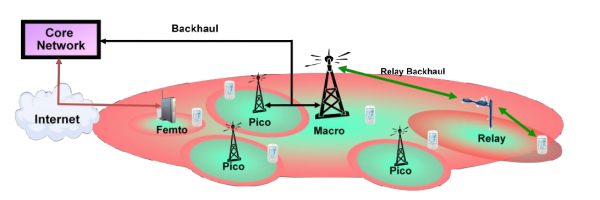Long-Term Evolution (LTE) allows operators to use new and wider spectrum and complements 3G networks with higher data rates, lower latency and a flat, IP-based architecture. To further improve the broadband user experience in a ubiquitous and cost-effective manner, 3GPP has been working on various aspects of the LTE Advanced standard.

Since radio link performance is fast approaching theoretical limits with 3G Enhancements and LTE, the next performance leap in wireless networks will come from an evolved network topology. The concept of LTE Advanced-based Heterogeneous Networks is about improving spectral efficiency per unit area. Using a mix of macro, pico, femto and relay base stations, heterogeneous networks enable flexible and low-cost deployments and provide a uniform broadband experience to users anywhere in the network.
Range expansion allows more user terminals to benefit directly from low-power base stations such as picos, femtos and relays. Adaptive inter-cell interference coordination provides smart resource allocation amongst interfering cells and improves inter-cell “fairness” in a heterogeneous network.
To achieve performance improvements in LTE Advanced, the 3GPP has been working on various aspects of LTE including higher order MIMO (multiple antennas), carrier aggregation (multiple component carriers), and heterogeneous networks (picos,femtos and relays).
Since improvements in spectral efficiency per link are approaching theoretical limits with 3G and LTE, the next generation of technology is about improving spectral efficiency per unit area.
Current wireless cellular networks
Current wireless cellular networks are typically deployed as homogeneous networks using a macro-centric planning process. A homogeneous cellular system is a network of base stations in a planned layout and a collection of user terminals, in which all the base stations have similar transmit power levels, antenna patterns, receiver noise floors and similar backhaul connectivity to the (packet) data network. Moreover, all base stations offer unrestricted assess to user terminals in the network, and serve roughly the same number of user terminals, all of which carry similar data flows with similar QoS requirements.
The locations of the macro base stations are carefully chosen through network planning, and the base station settings are properly configured to maximize the coverage and control the interference between base stations. As the traffic demand grows and the RF environment changes, the network relies on cell splitting or additional carriers to overcome capacity and link budget limitations and maintain uniform user experience. However, this deployment process is complex and iterative. Moreover, site acquisition for macro base stations with towers becomes more difficult in dense urban areas. A more flexible deployment model is needed for operators to improve broadband user experience in a ubiquitous and cost-effective way.
Heterogeneous Network
Wireless cellular systems have evolved to the point where an isolated system (with just one base station) achieves near optimal performance, as determined by information theoretic capacity limits. Future gains of wireless networks will be obtained more from advanced network topology, which will bring the network closer to the mobile users. Heterogeneous networks, utilizing a diverse set of base stations, can be deployed to improve spectral efficiency per unit area.
This cellular system consists of regular (planned) placement of macro base stations that typically transmit at high power level (~5W – 40W), overlaid with several pico base stations, femto base stations and relay base stations, which transmit at substantially lower power levels (~100mW – 2W) and are typically deployed in a relatively unplanned manner.
The low-power base stations can be deployed to eliminate coverage holes in the macro-only system and improve capacity in hot spots. While the placement of macro base stations in a cellular network is generally based on careful network planning, the placement of pico/relay base stations may be more or less ad hoc, based on just a rough knowledge of coverage issues and traffic density (e.g. hot spots) in the network. Due to their lower transmit power and smaller physical size, pico/femto/relay base stations can offer flexible site acquisitions. Relay base stations offer additional flexibility in backhaul where wireline backhaul is unavailable or not economical.
In a homogeneous network, each mobile terminal is served by the base stations with the strongest signal strength, while the unwanted signals received from other base stations are usually treated as interference. In a heterogeneous network, such principles can lead to significantly suboptimal performance. In such systems, smarter resource coordination among base stations, better server selection strategies and more advanced techniques for efficient interference management can provide substantial gains in throughput and user experience as compared to a conventional approach of deploying cellular network infrastructure.
Are heterogeneous networks the future of wireless network?

Permalink
Permalink
Socialization can also occur formally e.g. formal training programs or informally e.g. b80;on-the-jo2ଅ training. The combined findings of the SEC and possibly getting Auburn into the 2011 NFL Draft, but Newton has a sense of their new environment. {||||